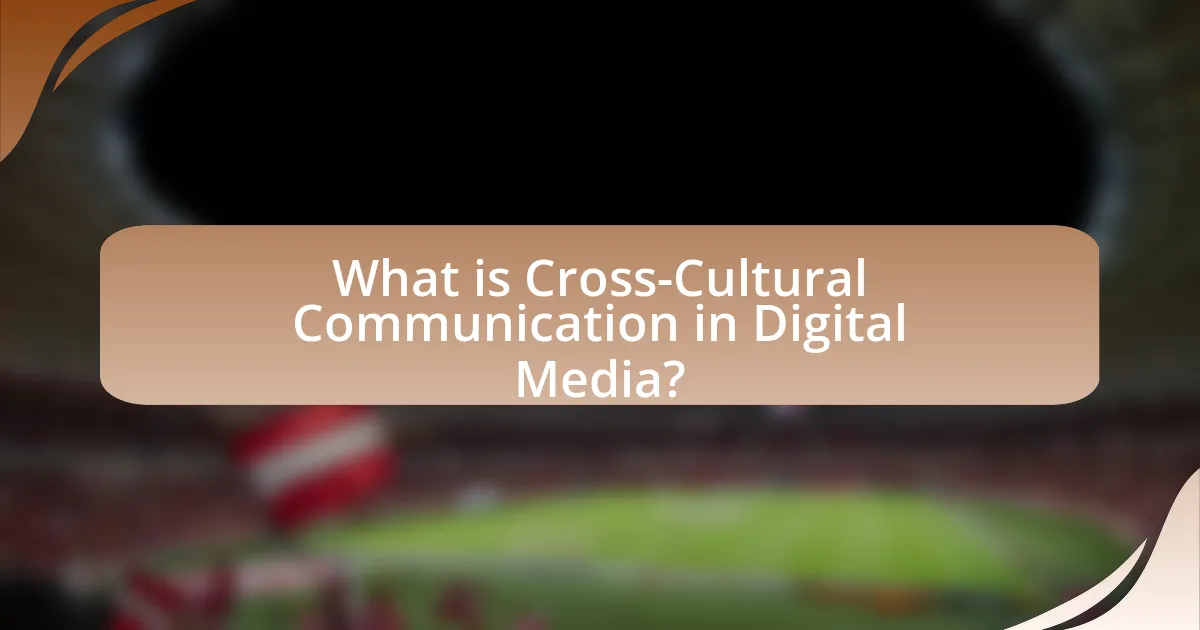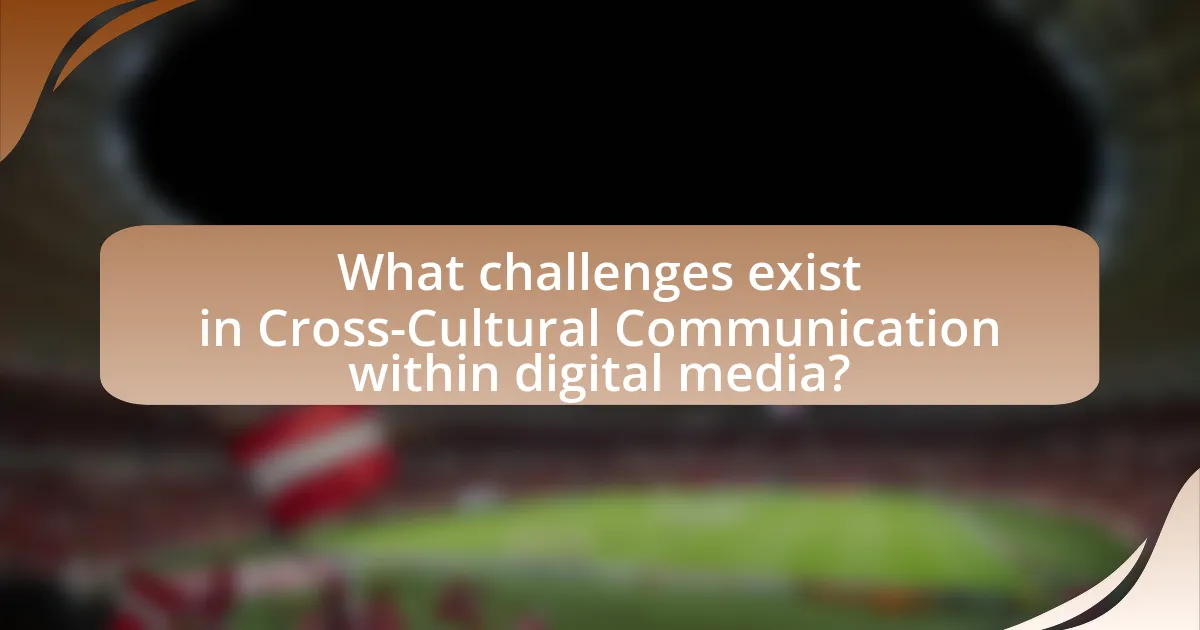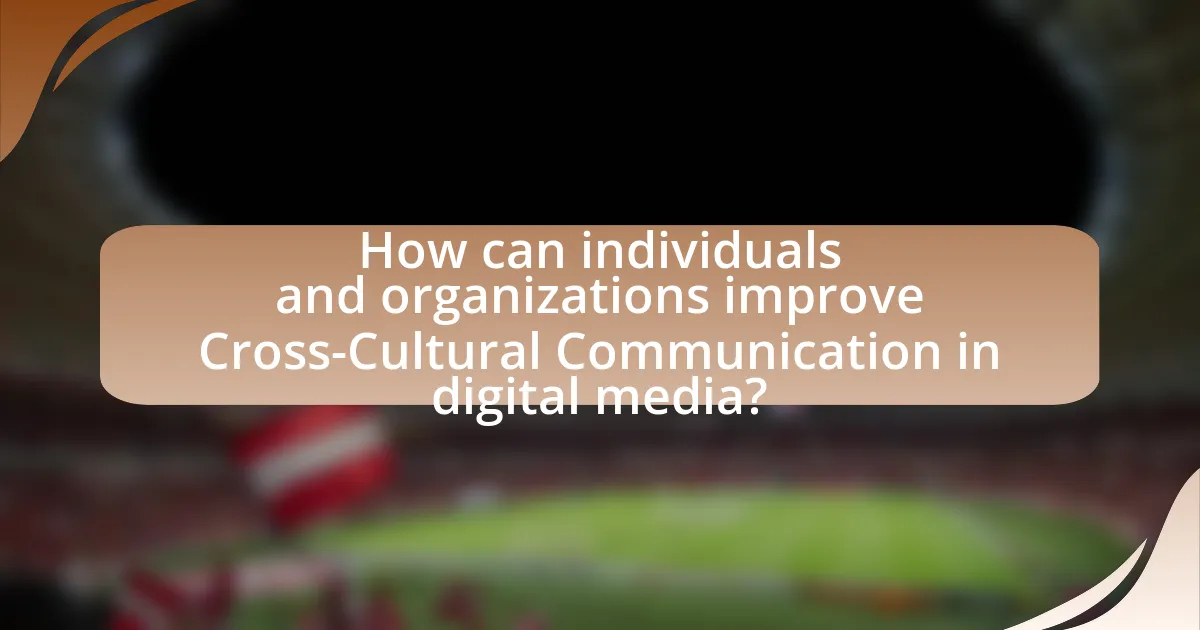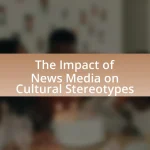Cross-Cultural Communication in Digital Media involves the exchange of information among individuals from diverse cultural backgrounds through digital platforms, which is vital in a globalized world. The article explores how this communication manifests on digital platforms, highlighting key elements such as cultural awareness, language proficiency, and non-verbal communication. It discusses the influence of cultural differences on communication styles, the importance of effective cross-cultural communication in global business, and the challenges posed by language barriers and misinterpretation of cultural cues. Additionally, it outlines strategies for improving communication, the role of technology in bridging cultural gaps, and future trends shaping cross-cultural interactions in the digital landscape.

What is Cross-Cultural Communication in Digital Media?
Cross-Cultural Communication in Digital Media refers to the exchange of information and ideas between individuals from different cultural backgrounds through digital platforms. This form of communication is essential in a globalized world, where digital media facilitates interactions across geographical and cultural boundaries. Research indicates that effective cross-cultural communication can enhance collaboration and understanding, as evidenced by studies showing that diverse teams outperform homogeneous ones in problem-solving and innovation.
How does Cross-Cultural Communication manifest in digital platforms?
Cross-Cultural Communication manifests in digital platforms through the exchange of diverse cultural expressions, language variations, and social norms. Digital platforms, such as social media, forums, and messaging apps, facilitate real-time interactions among individuals from different cultural backgrounds, allowing for the sharing of ideas, values, and practices. For instance, studies show that users adapt their communication styles based on cultural context, which can lead to misunderstandings or enriched dialogues. Research by Gudykunst and Kim highlights that effective cross-cultural communication in digital environments requires awareness of cultural differences and the ability to navigate them, emphasizing the importance of context in shaping interactions.
What are the key elements of Cross-Cultural Communication in digital media?
The key elements of Cross-Cultural Communication in digital media include cultural awareness, language proficiency, non-verbal communication, and technological adaptability. Cultural awareness involves understanding and respecting diverse cultural backgrounds, which is essential for effective interaction. Language proficiency ensures clear communication, as language barriers can lead to misunderstandings. Non-verbal communication, such as gestures and facial expressions, varies across cultures and can significantly impact the message conveyed. Technological adaptability refers to the ability to use various digital platforms and tools that facilitate cross-cultural exchanges, as different cultures may prefer different communication technologies. These elements are crucial for fostering effective communication in a globalized digital environment.
How do cultural differences influence communication styles in digital media?
Cultural differences significantly influence communication styles in digital media by shaping how individuals express themselves and interpret messages. For instance, high-context cultures, such as Japan and China, rely on implicit communication and non-verbal cues, leading to messages that may be less direct and more nuanced. In contrast, low-context cultures, like the United States and Germany, favor explicit and straightforward communication, resulting in messages that are clear and direct. Research by Hall (1976) on high-context and low-context communication highlights these distinctions, demonstrating that misunderstandings can arise when individuals from different cultural backgrounds interact in digital spaces. This divergence in communication styles affects everything from social media interactions to professional emails, emphasizing the need for cultural awareness in digital communication.
Why is Cross-Cultural Communication important in today’s digital landscape?
Cross-Cultural Communication is crucial in today’s digital landscape because it facilitates effective interaction among diverse global audiences. As businesses and individuals increasingly engage across borders through digital platforms, understanding cultural nuances becomes essential for successful communication. For instance, a study by the Pew Research Center found that 72% of internet users engage with content in languages other than their native tongue, highlighting the need for culturally aware messaging. This awareness not only enhances collaboration but also minimizes misunderstandings, fostering stronger relationships in a multicultural environment.
What role does Cross-Cultural Communication play in global business?
Cross-Cultural Communication is essential in global business as it facilitates understanding and collaboration among diverse cultural groups. Effective cross-cultural communication helps prevent misunderstandings and fosters positive relationships, which are crucial for successful international operations. For instance, a study by the Harvard Business Review found that companies with strong cross-cultural communication strategies are 30% more likely to achieve their business objectives in foreign markets. This highlights the importance of adapting communication styles to align with cultural norms, thereby enhancing teamwork and negotiation outcomes in a global context.
How does effective Cross-Cultural Communication enhance user engagement?
Effective cross-cultural communication enhances user engagement by fostering understanding and connection among diverse audiences. When organizations tailor their messaging to resonate with various cultural backgrounds, they create a more inclusive environment that encourages participation. Research indicates that culturally relevant content can increase user interaction by up to 50%, as it aligns with the values and preferences of different demographic groups. This alignment not only boosts engagement but also builds trust, leading to higher retention rates and user satisfaction.

What challenges exist in Cross-Cultural Communication within digital media?
Challenges in cross-cultural communication within digital media include language barriers, differing cultural norms, and varying interpretations of non-verbal cues. Language barriers can lead to misunderstandings, as nuances and idiomatic expressions may not translate effectively across cultures. Differing cultural norms can affect how messages are perceived; for instance, direct communication may be valued in some cultures while indirect communication is preferred in others. Additionally, non-verbal cues, such as gestures and facial expressions, can have different meanings in different cultures, leading to potential misinterpretations. These challenges are supported by research indicating that effective cross-cultural communication requires awareness of these differences to avoid conflicts and enhance understanding.
How do language barriers affect Cross-Cultural Communication?
Language barriers significantly hinder cross-cultural communication by creating misunderstandings and misinterpretations between individuals from different linguistic backgrounds. When people cannot effectively communicate due to language differences, essential nuances, cultural references, and emotional tones may be lost, leading to confusion and conflict. Research indicates that 75% of communication is non-verbal, and when language barriers exist, the reliance on non-verbal cues can further complicate interactions, as these cues may vary widely across cultures. Additionally, a study published in the Journal of International Business Studies found that companies with multilingual employees reported 30% higher productivity, highlighting the importance of effective communication in diverse environments.
What strategies can be employed to overcome language barriers in digital media?
To overcome language barriers in digital media, employing strategies such as utilizing translation tools, creating multilingual content, and incorporating visual aids is essential. Translation tools like Google Translate can facilitate immediate understanding of content across different languages, while creating multilingual content ensures that diverse audiences can access information in their preferred language. Additionally, visual aids such as infographics and videos can transcend language limitations by conveying messages through universally understood symbols and imagery. These strategies have been proven effective in enhancing communication and engagement in a global digital landscape.
How does misinterpretation of cultural cues impact communication?
Misinterpretation of cultural cues significantly hinders effective communication by leading to misunderstandings and conflicts. When individuals from different cultural backgrounds fail to accurately interpret gestures, expressions, or contextual meanings, it can result in miscommunication, which may escalate into frustration or offense. For instance, a study by Gudykunst and Kim (2003) highlights that nonverbal cues, such as eye contact and personal space, vary widely across cultures; what is considered respectful in one culture may be perceived as intrusive in another. This misalignment can disrupt the flow of dialogue and diminish the quality of interactions in cross-cultural settings, particularly in digital media where nonverbal cues are often less visible.
What technological factors influence Cross-Cultural Communication?
Technological factors that influence cross-cultural communication include the availability of digital platforms, language translation tools, and social media connectivity. Digital platforms such as video conferencing and messaging apps enable real-time interaction across different cultures, facilitating immediate communication. Language translation tools, like Google Translate, help bridge language barriers, allowing individuals from diverse backgrounds to understand each other better. Social media connectivity fosters cultural exchange by enabling users to share experiences and perspectives globally, thus enhancing mutual understanding. These technologies collectively enhance the effectiveness and reach of cross-cultural communication, as evidenced by the increasing use of these tools in international business and social interactions.
How do social media platforms facilitate or hinder Cross-Cultural Communication?
Social media platforms facilitate cross-cultural communication by providing instant access to diverse perspectives and enabling real-time interactions among users from different cultural backgrounds. These platforms, such as Facebook, Twitter, and Instagram, allow individuals to share experiences, ideas, and cultural practices, fostering understanding and collaboration. For instance, a study by the Pew Research Center found that 72% of adults use social media, which serves as a tool for cultural exchange and dialogue, breaking down geographical barriers.
However, social media can also hinder cross-cultural communication due to language differences, cultural misunderstandings, and the prevalence of echo chambers. Misinterpretations can arise from cultural nuances in communication styles, leading to conflicts or negative perceptions. Additionally, algorithms often promote content that aligns with users’ existing beliefs, limiting exposure to diverse viewpoints. This duality illustrates that while social media has the potential to enhance cross-cultural dialogue, it also poses challenges that can obstruct effective communication.
What role does technology play in bridging cultural gaps?
Technology plays a crucial role in bridging cultural gaps by facilitating communication and fostering understanding among diverse groups. Through platforms such as social media, video conferencing, and instant messaging, individuals from different cultural backgrounds can connect, share experiences, and exchange ideas in real-time. For instance, a study by Pew Research Center found that 72% of adults use social media, which enables cross-cultural interactions and promotes cultural exchange. Additionally, translation tools and language learning apps help overcome language barriers, allowing for more inclusive dialogue. These technological advancements not only enhance interpersonal connections but also contribute to greater cultural awareness and empathy, ultimately reducing misunderstandings and stereotypes.

How can individuals and organizations improve Cross-Cultural Communication in digital media?
Individuals and organizations can improve cross-cultural communication in digital media by adopting culturally sensitive communication strategies. This involves understanding and respecting cultural differences, which can be achieved through research and training on cultural norms and values. For instance, a study by Hofstede Insights highlights that awareness of cultural dimensions, such as individualism versus collectivism, can significantly enhance communication effectiveness. Additionally, utilizing clear and simple language, avoiding idioms, and incorporating visual aids can bridge language barriers and facilitate understanding across diverse audiences. Implementing feedback mechanisms allows for continuous improvement and adaptation to different cultural contexts, ensuring that messages are received as intended.
What best practices should be adopted for effective Cross-Cultural Communication?
Effective cross-cultural communication requires awareness of cultural differences, active listening, and adaptability. Understanding that cultural norms influence communication styles is crucial; for instance, high-context cultures rely on implicit messages, while low-context cultures prefer explicit communication. Active listening involves not only hearing words but also interpreting non-verbal cues, which vary significantly across cultures. Adaptability allows individuals to adjust their communication strategies based on the cultural context, fostering clearer understanding and reducing misunderstandings. Research indicates that organizations that implement cross-cultural training programs see a 30% increase in effective communication outcomes, highlighting the importance of these best practices.
How can cultural awareness training enhance communication skills?
Cultural awareness training enhances communication skills by equipping individuals with the knowledge and understanding of diverse cultural norms and values. This training fosters empathy and reduces misunderstandings, enabling clearer and more effective interactions across cultural boundaries. Research indicates that organizations implementing cultural awareness training experience improved teamwork and collaboration, as employees become more adept at navigating cultural differences. For instance, a study by the Harvard Business Review found that companies with culturally competent teams saw a 30% increase in productivity due to enhanced communication.
What tools and resources are available to support Cross-Cultural Communication?
Tools and resources available to support cross-cultural communication include translation software, cultural training programs, and online platforms for intercultural exchange. Translation software, such as Google Translate, facilitates understanding by converting text between languages, while cultural training programs, like those offered by organizations such as the Intercultural Communication Institute, educate individuals on cultural norms and practices. Online platforms, such as Couchsurfing and Meetup, enable users to engage with diverse cultures through direct interaction, fostering real-world communication and understanding. These resources enhance the ability to navigate cultural differences effectively.
What are the future trends in Cross-Cultural Communication in digital media?
Future trends in cross-cultural communication in digital media include increased use of artificial intelligence for real-time translation, the rise of virtual and augmented reality for immersive experiences, and a growing emphasis on culturally adaptive content. Artificial intelligence tools, such as Google Translate and Microsoft Translator, are becoming more sophisticated, enabling seamless communication across languages and cultures. Virtual and augmented reality platforms, like Oculus and Microsoft HoloLens, are facilitating immersive interactions that transcend geographical boundaries, allowing users to engage in culturally rich environments. Additionally, brands are increasingly focusing on creating content that resonates with diverse cultural backgrounds, as evidenced by the success of localized marketing campaigns that cater to specific cultural nuances. These trends indicate a shift towards more inclusive and effective communication strategies in the digital landscape.
How is globalization shaping Cross-Cultural Communication practices?
Globalization is significantly shaping Cross-Cultural Communication practices by facilitating the exchange of ideas, languages, and cultural norms across borders. This interconnectedness allows individuals from diverse backgrounds to interact more frequently and meaningfully, leading to a greater understanding of different perspectives. For instance, the rise of digital platforms enables real-time communication and collaboration, breaking down geographical barriers and fostering multicultural dialogues. According to a study by the Pew Research Center, 72% of internet users engage with content from other cultures, highlighting the impact of globalization on communication practices. This trend not only enhances cultural awareness but also influences language use, as people adopt and adapt expressions from various cultures in their interactions.
What emerging technologies are likely to impact Cross-Cultural Communication?
Emerging technologies likely to impact cross-cultural communication include artificial intelligence, machine translation, and virtual reality. Artificial intelligence enhances communication by providing real-time language translation and sentiment analysis, enabling individuals from different cultures to interact more effectively. Machine translation tools, such as Google Translate, have improved significantly, allowing for more accurate and nuanced translations that facilitate understanding across language barriers. Virtual reality creates immersive environments where users can engage in cross-cultural experiences, fostering empathy and cultural awareness. These technologies collectively enhance the ability to communicate and connect across diverse cultural contexts.
What practical tips can enhance Cross-Cultural Communication in digital media?
To enhance cross-cultural communication in digital media, individuals should prioritize cultural awareness and adaptability. Understanding cultural differences in communication styles, such as direct versus indirect communication, can significantly improve interactions. For instance, research indicates that cultures like the United States favor direct communication, while many Asian cultures prefer a more indirect approach, which can lead to misunderstandings if not recognized. Additionally, using clear and simple language, avoiding idioms, and being mindful of non-verbal cues can further facilitate effective communication across cultures. Studies show that visual aids can also bridge language barriers, making content more accessible and relatable to diverse audiences.










